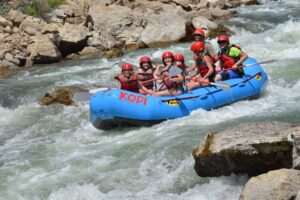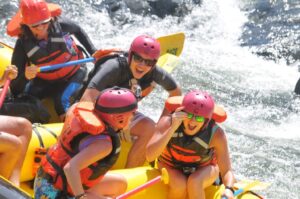White water rafting can be challenging but is not necessarily hard. It requires teamwork, physical exertion, and mental readiness.
White water rafting is a thrilling outdoor adventure activity that involves navigating rapids and rough water in a raft. While it may seem intimidating, it is an activity that anyone can enjoy regardless of experience or physical ability. Although some rapids may be more challenging than others, the overall difficulty level of white water rafting largely depends on the individual’s comfort level with water and the level of teamwork involved.
Proper gear, along with a seasoned guide, can make the experience safer and more enjoyable. Ultimately, the thrill and exhilaration of conquering the rapids make white water rafting a popular and worthwhile activity for adventure-seekers.

Credit: www.tripadvisor.co.za
What Is White Water Rafting And How Is It Done?
White water rafting is an extreme sport that has gained popularity in recent years. It involves riding on the rapids in a large inflatable raft with a team of people. We’ll discuss what white water rafting is, the equipment required, and the different grades of white water rafting.
Definition Of White Water Rafting
White water rafting is an exciting outdoor activity that involves navigating a river’s rapids in a large inflatable boat, commonly known as a raft. The activity is done in teams, with each member paddling the raft to control its direction and speed.
The water in a river is graded based on its difficulty level. The grades range from class i (easy) to class vi (extremely difficult).
The Equipment Required For White Water Rafting
White water rafting requires specific equipment to ensure the safety and enjoyment of every participant. Here are the different pieces of equipment required for white water rafting:
- Raft: The raft must be sturdy enough to withstand the rugged water and large enough to accommodate the team.
- Paddle: Paddles are used to navigate the raft through the rapids and must be appropriately sized.
- Personal flotation devices (pfds): Pfds are worn by every participant to keep them afloat in the water.
- Helmet: Helmets protect the head from any injuries in case of an accident.
- Wetsuit: A wetsuit provides insulation and prevents hypothermia in cold water.
- Waterproof footwear: Participants require waterproof shoes with good traction to prevent slipping on the rocks.
The Different Grades Of White Water Rafting
White water rapids are classified into six grades, from class i to class vi. The grading system is based on the difficulty level of the rapids and the challenge they offer. Here are the different grades of white water rafting:
- Class i: Easy and mild rapids with small waves and little risk.
- Class ii: Easy rapids with straightforward maneuvering and slight waves.
- Class iii: Moderately difficult rapids with higher waves and stronger currents.
- Class iv: Difficult rapids with powerful waves and unpredictable currents.
- Class v: Extremely difficult rapids with long and violent rapids.
- Class vi: Unnavigable rapids with significant drops and huge obstacles.
Now that you have a better understanding of what white water rafting entails, you can decide if you’re ready to take on one of the world’s most exciting outdoor activities. Remember to adhere to safety precautions and enjoy the ride!
Preparing For A White Water Rafting Adventure
Are you gearing up for a white water rafting adventure soon? It’s an exhilarating experience, but if you are a beginner, it’s natural to wonder if it’s going to be hard. Well, the answer is yes and no. It can be both challenging and enjoyable, but with proper preparation, and a reputable guide service, you’re in for an unforgettable experience.
Physical Fitness And Health Considerations
White water rafting can be physically demanding. You’ll need to have at least moderate physical fitness. Some of the things you can do to prepare yourself include regular exercises such as running, going to the gym, or even hiking. It’s essential to have a healthy diet and drink plenty of water to keep your body hydrated.
You should also consider your overall health, such as any pre-existing medical conditions or injuries. It’s best to talk to your doctor about whether white water rafting is appropriate for you.
Mentally Preparing For The Challenge
Aside from physical preparation, you’ll also need to prepare yourself mentally for the challenge. White water rafting involves overcoming fear, building teamwork, and having quick reflexes. You’ll need to have a positive attitude and a willingness to learn. Try to visualize yourself enjoying the adventure, but also accepting any potential challenges.
It’s a good idea to research what to expect from the experience. Knowing what’s ahead can help manage your expectations and put you at ease.
Essential Safety Tips
Safety should be your top priority when going on a white water rafting adventure. Some general safety tips you should keep in mind include:
- Always listen to your guide and follow their instructions.
- Wear a life jacket and helmet at all times.
- Stay in the raft unless your guide tells you to swim.
- Keep your feet up, pointing downstream if you fall into the water.
- Avoid consuming drugs or alcohol before or during the trip.
Finding A Reputable Guide Service
Choosing a reputable guide service is critical when planning your white water rafting adventure. You want a service that puts safety as its top priority. Do your research by reading customer reviews, checking their certifications, and ensuring that they have adequate insurance coverage.
You should also ask about their experience and training of their guides.
White water rafting can be both hard and fun, but with the right preparations, safety measures, and reputable guide service, you’ll have an unforgettable experience. Remember to stay relaxed, listen to your guide, and enjoy the ride.
Frequently Asked Questions On Is White Water Rafting Hard
Is White Water Rafting Dangerous?
White water rafting can be dangerous if proper safety measures are not taken. It is important to choose a reputable outfitter and wear suitable gear such as life jackets and helmets.
How Difficult Is White Water Rafting?
The difficulty of white water rafting varies depending on the river and the section being navigated. Beginners can start with class i and ii rapids, while more advanced rafters can tackle class v and vi rapids.
Can You Go White Water Rafting If You Can’T Swim?
While it is recommended that you have basic swimming skills, it is possible to go white water rafting without being a strong swimmer. Wearing a life jacket is mandatory and rafting guides are trained to handle emergencies.
Conclusion
After reading this blog post, it’s clear that white water rafting is a challenging and thrilling activity. While it requires physical fitness and some technical skills, beginners can also enjoy it with proper training and guidance. Safety should always be a top priority, and choosing the right level of difficulty and gear is crucial to have a fun and secure experience.
With the right attitude, open-mindedness, and respect for nature, white water rafting can also be a way of connecting with oneself, friends, and the environment. Whether you are an adrenaline junkie or just looking for a unique outdoor activity, white water rafting can offer you a memorable and rewarding adventure.
So don’t hesitate to grab a paddle, put on a life jacket, and hit the rapids to challenge yourself and explore the beauty and power of water.



